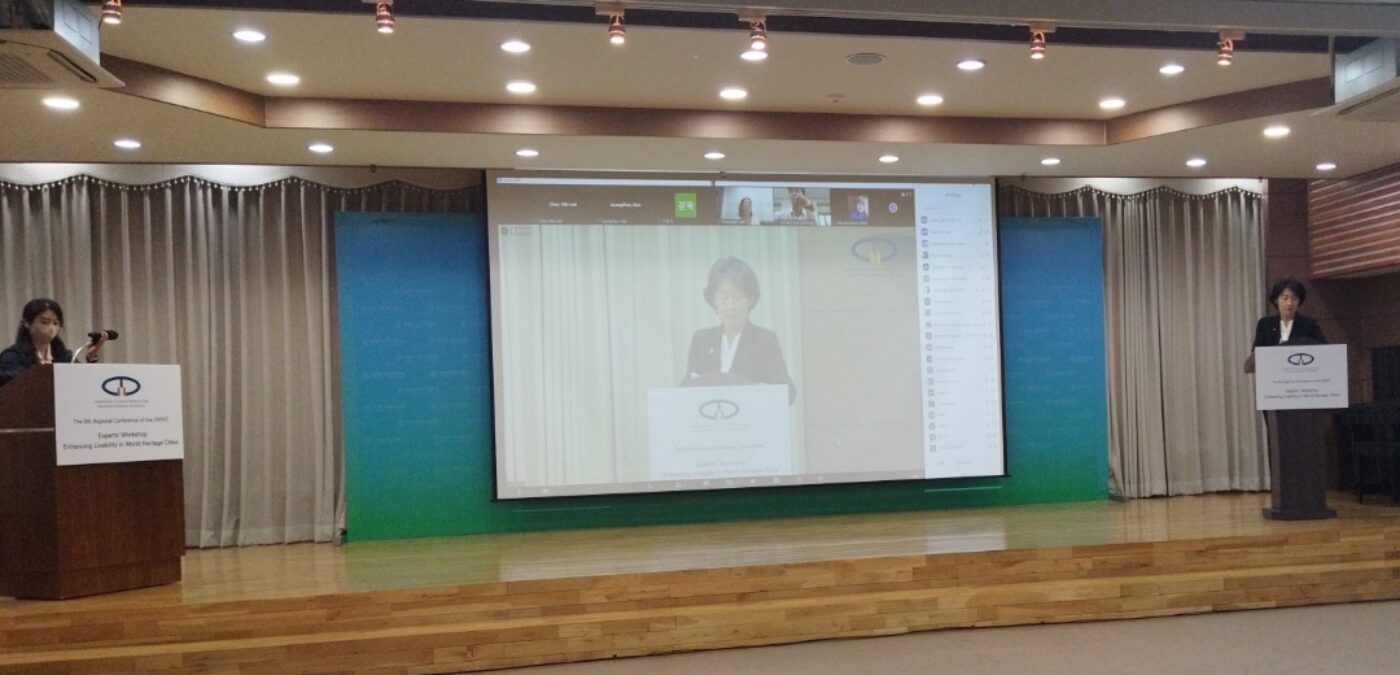31 May 2022
The 6th OWHC-AP Regional Experts’ Workshop Shows Great Enthusiasm and Success
Gyeongju, Republic of Korea

The OWCH Asia-Pacific Regional Secretariat (based in Gyeongju, Republic of Korea) hosted the 6th OWHC-AP Reginal Experts’ Workshop at the UNESCO Hall in Seoul Metropolitan City on May 19th.
Under the theme of “Enhancing livability in World Heritage Cities,” the workshop explored various potential ways to develop World Heritage Cities in a balanced and harmonious manner through the preservation and utilization of World Heritage Sites and enhancement of the quality of life for the residents. Case studies of 4 South Korean cities – Gyeongju, Buyeo, Iksan, Gongju, were presented, followed by others of non-Korean Asia-Pacific cities – Okinawa (Japan), Macao (China) and Denpasar (Indonesia).
The first presentation was made by Professor Mie Ok Chae of Daegu University, titled “Living Environment Regeneration through Holistic Cultural Environment Conservation Approach of Korea”. Her thesis focused on the housing and living environment improvement projects based on the restoration of the World Heritage Sites and the cultural landscapes that were implemented in the four(4) ancient capital cities across Republic of Korea. She evaluated that these projects provided the residents to recognize the World Heritage as a valuable, propelling force that positively contribute to the development of their local areas as well as the improvement of the quality of life. Overall, she concluded that the livability was enhanced the livability and the living environment for the residents.
Dr. Jihon Kim, the Senior Programme a Specialist of the Korean National Committee for UNESCO, discussed her presentation titled “Participation of the Local Community in Governance for World Heritage Protection and Promotion: The Case of Korean World Heritage Cities.” Her findings demonstrated the role a municipal government plays in actively promoting its policies and activities related to their World Heritage in order to encourage local residents’ voluntary participation.
In a collaborated presentation, Dr. Jihye Gil of ICOMOS Korea and Dr. Hyeseung Shim, a researcher at the Korea Advanced Institute of Science and Technology, presented on “Bringing World Heritage Cities to Life though Building Networks of Public Spaces: Focused on Iksan City, Republic of Korea.” Both researchers analyzed the public space network of Iksan City of Republic of Korea from the perspectives of connecting Cultural Heritages and a natural environment as well as connecting spaces and residents through cultural institutions. Their findings pointed to the potential a city may develop into a dynamic World Heritage City.
Jiyoung Kim, a researcher professor of Korean National University of Cultural Heritage, drew the audience’s attention to how climate change disrupted ecology and caused natural disasters that directly affected the health and life of the residents of the World Heritage Cities and preservation effort for World Heritage in her presentation “Climate Friendly World Heritage City – a Case of Buyeo”. She introduced to the audience the plans and strategies of Buyeo County, which involves improvement in environmental and transportation infrastructure, efforts for disaster reduction, construction of an Eco Park.
Experts from outside of Republic of Korea joined the workshop via Zoom. Professor Hajime Shimizu of University of Ryukyus emphasized the importance of a local community in constructing the historical environment. Titled “Preservation of Historical Alleys and Improvement of Living Environment in Shuri-kinjo District, Okinawa, Japan”, he analyzed the Outstanding Universal Value of the Shuri castle, included in the Gusuku Sites and Related Properties of the Kingdom of Ryukyu, inscribed on the list of the UNESCO Heritage in 2000. Added to this, he also introduced the current status of the restoration effort and the municipal government’s project to improve the surrounding landscape and quality of life for the residents.
Joining from Denpasar, Indonesia, Professor Agung Suryawan Wiranatha of Udayana University presented the five phases involved in the Restoration of the Main Gate of Denpasar Customary Village Temple as a Conservation of Cultural Heritage. Particularly, Professor Agung introduced the traditional ceremony of Bali, thereby positing a good example in which the connection between the Cultural Heritage, the surrounding landscape, and the Intangible Heritage.
Finally, Lui Cha Keong, an architect as well as a member of ICOMOS China, made a presentation with a thesis on how the public space of Patio de Espinho is arranged is not only to optimize cultural tourism facility, but it also displays the relationship between Jesuit and the Japanese Catholics in Macau in the early 17th century. Further, he added that the design of the public space reflects the relationship between Macau’s Intangible Cultural Heritage, archeological sites, and the Japanese Catholics. His presentation is titled “Na Tcha Museum and Arrangement of Public Space of Patio Espinho in Macau Historical Center.”
In the discussion session which followed the presentations, the presenters and the discussion panel, as well as the heritage site managers of 50(fifty) personnel took part in discussions that explored in-depth the issues regarding the preservation of World Heritage in the World Heritage Cities, the enhancement of quality of life for the residents, and related prospect and solutions.


